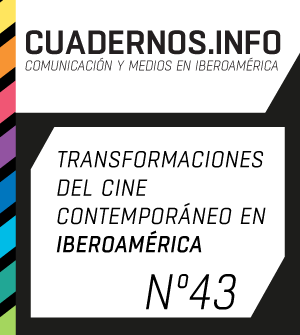Según el favor del viento. Paisajes sonoros en el cine brasileño: de Rocha a Mascaro
DOI:
https://doi.org/10.7764/cdi.43.1419Palabras clave:
Cinema Novo, Novíssimo Cinema Brasileiro, paisaje sonoro, géneroResumen
Este artículo analiza comparativamente los films Barravento (1962), primer largometraje de Glauber Rocha, emblemático del Cinema Novo, y Ventos de agosto (2014) de Gabriel Mascaro, del Novíssimo Cinema Brasileiro. El foco puesto en el viento busca pensar los modos de figurar la relación entre el cine y lo político. Estas dos películas capturan el rumbo del viento desde dimensiones opuestas –la violencia o la vacuidad, la tempestad o la brisa arremolinada– que permiten ensayar una reflexión sobre las formas de lo sensible a partir de las dinámicas de lo imperceptible
Descargas
Citas
Araújo Silva, M. (2007). Godard, Glauber e o Vento do leste: alegoria de um (des)encontro [Godard, Glauber and the Wind of the East: allegory of a (dis) encounter]. Devires – Cinema e Humanidades, 4(1), 36-63. Retrieved from http://www.fafich.ufmg.br/devires/index.php/Devires/article/view/277/142
Bachelard, G. (2012). El aire y los sueños [Air and Dreams: An Essay on the Imagination of Movement]. Mexico City: Fondo de Cultura Económica.
Bentes, I. (2003). The sertão and the favela in contemporary Brazilian film. In L. Nagib (Ed.), The New Brazilian Cinema (pp. 121-138). New York: The Centre for Brazilian Studies, University of Oxford.
Böhme, G. & Böhme, H. (2012). Fuego, agua, tierra, aire. Una historia cultural de los elementos [Fire, water, earth, air. A cultural history of elements]. Barcelona: Herder.
Colaizzi, G. (2007). La pasión del significante. Teoría de género y cultura visual [The passion of the signifier. Gender theory and visual culture]. Madrid: Biblioteca Nueva.
Cunha, D. (2013). O som e as suas dimensões concretas e subjetivas nos filmes de Lucrecia Martel [The sound and its concrete and subjective dimensions in the films of Lucrecia Martel] (Master’s thesis). Retrieved from http://www.teses.usp.br/teses/disponiveis/27/27161/tde-12092013-154104/pt-br.php
Daney, S. (1998). Trop tôt, trop tard. In Ciné journal, vol. 1 (1981-1982) (pp. 125-131). Paris: Cahiers du cinéma.
Daney, S. (2004a). Antes y después de la imagen [Before and after the image]. In Cine, arte del presente [Cinema: the art of present] (pp. 269-276). Buenos Aires: Santiago Arcos.
Daney, S. (2004b). La muerte de Glauber Rocha [The death of Glauber Rocha]. In Cine, arte del presente [Cinema: the art of present] (pp. 99-102). Buenos Aires: Santiago Arcos.
de Lauretis, T. (1996). La tecnología del género [Gender Technologies]. Mora, 2, 6-34. Retrieved from http://genero.institutos.filo.uba.ar/sites/genero.institutos.filo.uba.ar/files/revistas/adjuntos/Mora2.pdf
Debray, R. (1994). Vida y muerte de la imagen. Historia de la mirada en Occidente [Life and death of the image. Look at history of the West]. Buenos Aires: Paidós.
Eisenstein, S., Pudovkin, V., & Aleksándrov, G. (1967). Una declaración [A declaration]. In Eisenstein. El sentido del cine. La forma en el cine. Problemas de la composición cinematográfica. Notas de un director de cine [Eisenstein. The meaning of cinema. The form in the cinema. Problems of cinematographic composition. Notes of a film director] (pp. 369-372). La Habana: Ediciones ICAIC.
Ellis, R. D. (Producer) & Mascaro, G. (Director). Ventos de agosto (2014) [August Winds]. Brazil.
Grüner, E. (2017). El justo viento [The just wind]. In Siwa V. Biblioteca Universal de Literatura Geográfica. Historia natural y moral de los vientos [Siwa V. Universal Library of Geographic Literature. Natural and moral history of the winds] (pp. 33-36). Buenos Aires: Argentina.
Ikeda, M. (2015). Cinema brasileiro a partir da retomada. Aspectos econômicos e políticos [Brazilian cinema from the beginning. Economic and political aspects]. Sao Paulo: Summus.
Jobim, A. C. & de Moraes, V. (1958). A felicidade. On Black Orpheus [Film]. Brazil.
Kratje, J. (2018). Un cine de ideas. Fotografía y afecto en Histórias que só existem quando lembradas (Julia Murat, 2011) y Viaje sentimental (Verónica Chen, 2010) [A cinema of ideas. Photography and affect in Histórias que só existem quando lembradas ( Julia Murat, 2011) y Viaje sentimental (Verónica Chen, 2010)]. 452ºF, Revista de Teoría de la literatura y Literatura Comparada, 18, 88-105. Retrieved from http://revistes.ub.edu/index.php/452f/article/view/19844
Netto, B. (Producer) & Rocha, G. (Director). (1962). Barravento [Motion Picture]. Brazil.
Lopes, D. (2012). No coração do mundo [In the heart of the world]. Rio de Janeiro: Rocco.
Oubiña, D. (2016). El fin de lo nuevo (cineastas, autores, Argentina, 1969) [The end of the new (filmmakers, authors, Argentina, 1969)]. Cuadernos Lírico, (15), 1-12. Retrieved from https://journals.openedition.org/lirico/2980
Pound, E. (1970). Selected Cantos of Ezra Pound. New York, United States: New Directions.
Rocha, G. (2004). Revolução do cinema novo [Revolution of Cinema Novo]. Sao Paulo: Cosac Naify.
Spiner, L. (2017). El viento [The wind]. Revista de cine, 4(4), 69-72.
Stam, R. (2003). Cabral and the Indians: filmic representations of Brazil’s 500 years. In L. Nagib (Ed.), The New Brazilian Cinema (pp. 205-228). New York: The Centre for Brazilian Studies, University of Oxford.
Taveira Fernandes, L. (2018). Cuerpos, deserción y cotidiano en el nuevo cine pernambucano [Bodies, desertion and quotidian in the new Pernambuco cinema]. Toma Uno, 6(6), 61-77. Retrieved from https://revistas.unc.edu.ar/index.php/toma1/article/view/20895
Tejada Gómez, A. & Isella, C. (1969). Canción con todos [Recorded by Mercedes Sosa]. On Canción con todos. Mercedes Sosa [Phonogram]. Argentina.
Vakar, I. & Eisenstein, S. (1938). Alexander Nevsky [Motion Picture]. Russia, Amkino.
Xavier, I. (2007). Sertão Mar. Glauber Rocha e a estética da fome [Sertão Mar. Glauber Rocha and the aesthetics of hunger]. Sao Paulo: Cosac Naify.
Xavier, I. (2008). El discurso cinematográfico. La opacidad y la transparencia [The cinematographic discourse. Opacity and transparency]. Buenos Aires: Manantial.
Xavier, I. (2011). Prólogo [Foreword]. In G. Rocha, La revolución es una eztétyka [Revolution is an eztétyka] (pp. 9-21). Buenos Aires: Caja Negra.
Xavier, I. (2013). Cine brasileño contemporáneo [Contemporary Brazilian Cinema]. Buenos Aires: Santiago Arcos















